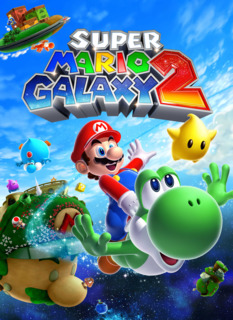Super Mario Galaxy 2 is the best 3D platformer to date, as well as one of the best video games of all time.
Starting out with a 3D-styled 2D level in the vein of New Super Mario Bros. Wii (that ironically plays even better than that game), we are teased by a few simplistic sidescrolling sequences. It doesn't take long, however, before a third dimension is added with incredibly subtlety and ease, and we are allowed to move around in any direction we may please. Still, it is only revealed what we are dealing with when we are launched into orbit in pursuit of Bowser, who has done the inevitable by kidnapping Peach for the umpteenth time. The adventure really gets started when you have to guide Mario through a space station in a manner that feels familiar, yet awfully refreshing in a certain way. Soon after, you find yourself on a spaceship shaped after Mario's face, which serves as a portable hubworld, making navigation between different worlds faster and more comfortable than in the first Super Mario Galaxy, yet leaving players with their own bit of spacerock to fool around with.
As more worlds are explored, the fear that we are dealing with a glorified expansion pack quickly makes room for a slightly infantile sensation that will make players smile just like when they were playing Super Mario Bros. 3 for the first time. The uniqueness of every single star (mission) in every single galaxy (level) makes one wonder how long this creativity rush can be kept up: new gameplay implementations can be found everywhere, while the intelligent game design and near flawless gameplay mechanics go far beyond anywhere a 3D platformer has ever been before - including the first Galaxy. Even more surprisingly, this trend continues throughout all of the first 120 stars, and even seems to be increasing as players find themselves closer to the conclusion of the main storyline. Some locations from previous Mario platformers are revisited, but even then the innovative new missions make them seem like new places altogether. It's as if Nintendo wanted to show just how superior Super Mario Galaxy 2 is to every 3D platformer ever created, including their own past efforts.
To add to the amazingly clever gameplay, the Wii's technical limits are once again being pushed by the same incredible graphics of Super Mario Galaxy 1, aided by artistic design that even outdoes that of the first. Super Mario Galaxy 2 is not just the best-looking Wii game - it is one of the most visually appealing video games on the entire market, period. The music also borrows from the past, yet does not limit itself to mere copying. Even if there still are many great all-new music tracks to be found, the familiar tunes have received such an overhaul that they can be enjoyed all over again. The Bowser level music, for example, has been there since Super Mario 64, but only now has it been perfected - at least until Nintendo's next Mario game.
In games such as Super Mario Galaxy 2, it is hard to find flaws. Not because the overall experience is so great that it's easy to overlook them, but because they simply are barely present at all. And if they are there, they are no more than flaws - minor imprecisions rather than major shortcomings or errors. Examples include the camera, which will occasionally still freeze behind walls, and the fact that the 120 green stars you will have to find after finding the 120 yellow ones just aren't as compelling as the initial challenges.
Some will cite the story (or lack thereof) as a shortcoming, but when taking a look at Super Mario Galaxy 2's bizarre world, one can understand why Nintendo purposely opted to not try and go for a more sophisticated storytelling experience. All of the worlds are so abstract, creative, and indeed otherworldly (the word 'Galaxy' in the title doesn't only refer to the setting), that they would often have defied all logic, had there been one. Fortunately, however, Super Mario Galaxy 2 is completely free of such a burden (that often comes with a more complicated story). Players will never have to wonder why certain enemy types are found in certain places, and why this or that place looks as it does, allowing them to focus fully on the fluid, superior gameplay experience.
And maybe that is why gamers should stop trying to cram video games into a - often flawed - definition of art. Or exclude it. Video games, especially ones like Super Mario Galaxy 2, cannot be judged by parameters and criteria that have been around for centuries, even millennia. Yet this does not mean that Super Mario Galaxy 2 can be in any way excluded from praise similar to that received by brilliant books or movies. This game may not be created by artists in the strict sense of the word, but nearly everything about it, from its limitless creativity to its flawless gameplay mechanics, is a testament of the genius of a small group of men. Call it a form of artisanship or a job well done, but regardless from such qualifications, Super Mario Galaxy 2 is the best 3D platformer to date, as well as one of the best video games of all time, and it should be played by absolutely everyone carrying the label of 'gamer'.

